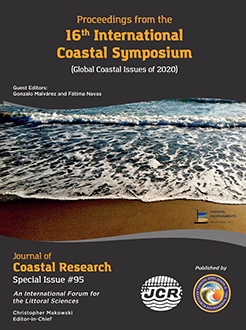Morales, J.A.; Sedrati, M.; Boulmirate, O.; Borrego, J., and Carro, B.M., 2020. Measuring dimensions of ship-generated waves in Guadalquivir Estuary banks (SW Spain): Hydrodynamic considerations. In: Malvárez, G. and Navas, F. (eds.), Global Coastal Issues of 2020. Journal of Coastal Research, Special Issue No. 95, pp. 568–572. Coconut Creek (Florida), ISSN 0749-0208.
Estuaries have always been very important to communities, as they often represent the economic centers of many countries. The estuarine banks, as fetch-limited environments, might be highly affected by some anthropogenic actions. Ship-generated waves are starting to be the subject of several studies in order to understand their impact on coastal environments. These waves might be the leading factor to erosion in estuarine channel margins when traffic is frequent. Guadalquivir is one of the most important estuaries in Spain. It connects an important number of commercial ships to the port of Seville. Along the estuary, bank erosion is highly pronounced which is starting to worry both, landowners and ecologists, since a part of the estuarine channel crosses the marine sector of Doñana natural park. Last years, port of Seville intended to dredge the channel to get the entrance of bigger ships to the port. Ecologists argue that the magnitude of the waves generated by the ships is proportional to the size of the ship. So, the entrance of bigger ships will increase the erosion along the margins. The aim of this paper, is to obtain preliminary data to verify the relevance of this theory through a hydrodynamic survey using wave gauges on the banks and an ADCP in the bottom of the channel to control the modification of waves and currents caused by the ships.





